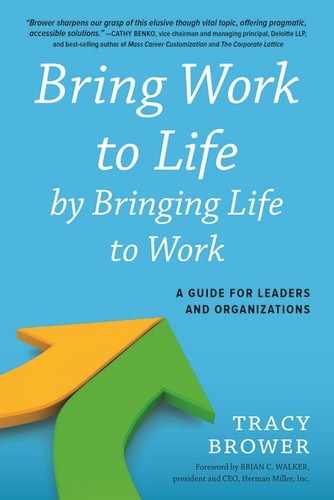CONCLUSION
Planting Trees
The best time to plant a tree is twenty years ago. The second best time is today. This is never more true than as it relates to work-life supports. Some organizations will say that they wish they’d implemented work-life supports long ago, but in lieu of previous implementation, there is no time like the present.
Employees must integrate—not balance—all the demands they face with work and life. When leaders and organizations support them in this effort by creating the conditions for abundance and joy throughout their lives, the investment will pay significant dividends in employee engagement, satisfaction, productivity, attraction and retention, and overall business results. Organizations must select work-life supports that are exactly right for them. The work-life supports must align with work, workplace, workers, performance systems, and the organization’s culture. In addition, organizations must pay attention to work team leaders and teams who are pivotal to the success of work-life supports.
There are multiple right answers when it comes to how leaders and organizations can implement work-life supports, so the considerations I suggest don’t point to a formulaic approach or one right answer. Instead, there are various approaches for organizations and leaders to consider. The right answer for any organization is a cocktail—the right mixture of work-life supports across areas of the business and customized for teams and individuals. To implement work-life supports that aren’t aligned with the organization’s values and direction would be folly and a waste of time because they wouldn’t work. Effectiveness of work-life supports is dependent on alignment to the business.
In establishing the right cocktail, it will be important to strive for “simplicity on the other side of complexity.” By this, I mean working through complexities as part of a process that should ultimately lead to simplicity. It is frequently messy in the middle of the process, but elegant simplicity is the goal. The simplicity does not mean “dumbing down” or simplifying. Instead, it means culling information so it is digestible and usable. “Simplicating” is finding the appropriate elegance after working through the complexity. Mark Twain is often (incorrectly) credited with the phrase “If I’d had more time, I’d have written a shorter letter.”1 The considerations presented in this book are designed to be the shorter letter—or the elegance in simplicity. It is a summary of what’s necessary to consider in the process of implementing work-life supports successfully.
The work-life solutions will need to be both systemic and systematic. For the solutions to be systemic, they will need to be integrated with multiple processes within the organization—financial processes, measurement processes, HR processes, training and development processes, and more. Additionally, they must be thorough and comprehensive in the parts of the organization they touch. At the same time, the solutions will need to be systematic. They must be well planned, organized, efficient, and logical in their sequential implementation.
Both agency and structure must be considered if work-life supports are to succeed, and their implementation is a matter of importance for individuals, leaders, and organizations. Individuals have a responsibility to be knowledgeable about work-life supports and to advocate for these supports in their organization. Leaders, too, have a level of individual accountability in making work-life supports successful. They should model the way through their own behaviors and decisions and they should continually set direction for the work-life supports that will most positively impact their area of the business. In these ways, both individuals and leaders have agency—personal choice and responsibility toward persuading organizations to implement greater work-life supports.
At the same time, organizations have responsibilities to create the conditions in which work-life integration and navigation can flourish. This is structure. Individuals—whether they are workers or leaders—will have a difficult time without structural supports for work-life integration. Finding the right solutions to work-life supports is not an either-or situation in which either individuals have responsibility or organizations have responsibility. The best solutions require both individual responsibility—agency—as well as organizational responsibility—structure.
In addition to addressing both agency and structure, organizations must be clear and explicit in describing how work-life supports fit into the overall framework through which the organization operates. Work-life supports must serve both people and the organization. If these are out of sync, the process won’t be sustainable. When people’s needs are maximized and the organization isn’t served, the benefits, policies, or practices won’t last because they won’t be profitable or advantageous to the organization. They may work in the short term, but they will be overturned in the long term, when the organization goes through cost reductions or when the economy cycles downward. Likewise, if organizational needs are maximized at the expense of worker needs, work-life supports will also be ineffective because attraction, retention, and engagement will suffer. Work-life supports are quickly becoming differentiators among companies, and those companies that don’t offer them will lose or fail to attract the best employees. The answers that any one company embraces for its cocktail of work-life supports must serve both individuals and the organization.
Finally, testing new approaches is rarely wrong. The best answer is positive action and forthright efforts toward a holistic solution. Companies will need to implement and execute repeatedly over time. Work will change, workers will change, the broader context will change, and companies will need to shift as well. Companies must implement, monitor, adjust, revise, and repeat. Even more than selecting the right work-life supports at the outset, success lies in renewal and adaptation so that work-life supports are responding to the realities of work and life on a continual basis.
Implementing work-life supports will be a lot of work. It will be worth it. It will benefit individuals and it will benefit organizations. It will create abundance and it will bring work to life.
